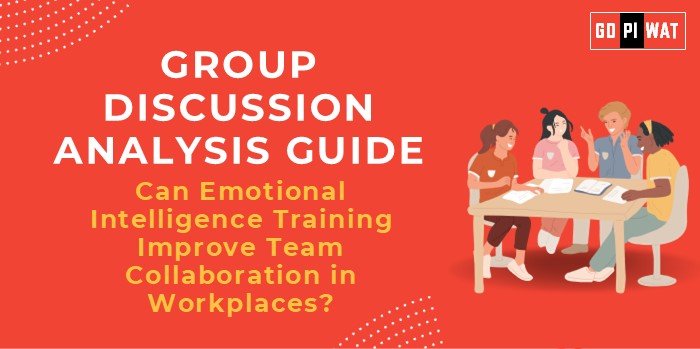📋 Group Discussion (GD) Analysis Guide
🌟 Topic: Can Emotional Intelligence Training Improve Team Collaboration in Workplaces?
🌐 Introduction to Emotional Intelligence (EI) and Its Role in Workplaces
Opening Context: “In a competitive corporate environment, technical skills may secure a job, but emotional intelligence is what builds successful teams and fosters workplace harmony.”
Topic Background: Emotional Intelligence (EI) refers to the ability to recognize, understand, and manage emotions, both in oneself and others. Coined by Daniel Goleman in the 1990s, EI has emerged as a critical factor in team dynamics and organizational success.
📊 Quick Facts and Key Statistics
- 75%: Employers view EI as more important than IQ in workplace success (LinkedIn, 2023).
- 90%: High performers in workplaces are shown to have high EI (Harvard Business Review).
- $500 billion: Global losses due to workplace stress and miscommunication annually (WHO, 2023).
- 31%: Increase in team productivity in organizations with EI training (Forbes, 2023).
👥 Stakeholders and Their Roles
- HR Departments: Designing EI training programs to improve team dynamics and collaboration.
- Corporate Leaders: Setting examples by demonstrating emotionally intelligent leadership.
- Employees: Integrating EI principles to improve communication, reduce conflicts, and strengthen collaboration.
- Training Consultants: Providing specialized EI programs tailored to organizational needs.
🏆 Achievements and Challenges
🎯 Achievements
- Enhanced Team Performance: EI training fosters empathy and better interpersonal communication, leading to improved collaboration.
- Reduced Conflicts: A 40% reduction in workplace conflicts was reported after EI workshops (Deloitte).
- Stronger Leadership: Emotionally intelligent leaders inspire trust, engagement, and motivation in teams.
- Improved Mental Well-being: EI promotes self-regulation, reducing stress and burnout in teams.
⚠️ Challenges
- Resistance to Training: Employees or leaders may undervalue the importance of EI, viewing it as a “soft skill.”
- Measuring EI Impact: Quantifying emotional intelligence improvements remains difficult.
- Cultural Barriers: Different cultures perceive and express emotions differently, creating challenges for global teams.
🌍 Global Comparisons
- Google’s Project Aristotle: Showed that psychological safety and emotional awareness are key factors in high-performing teams.
- Denmark: Emphasizes emotional intelligence in education and workplaces to maintain high employee satisfaction rates.
📚 Case Studies
- Microsoft: Implemented emotional intelligence training for team leaders, resulting in a 20% increase in team efficiency.
- Adobe: Introduced EI-focused leadership training, reducing team turnover by 30%.
📌 Structured Arguments for Discussion
✅ Supporting Stance
“Emotional intelligence training equips employees with essential interpersonal skills, directly improving collaboration and reducing workplace conflicts.”
❌ Opposing Stance
“While emotional intelligence is valuable, its training impact is hard to measure, and resources may be better spent on technical skill development.”
⚖️ Balanced Perspective
“EI training complements technical skills by fostering teamwork and trust, but its success depends on consistent application and organizational commitment.”
✨ Effective Discussion Approaches
Opening Approaches
- Statistical Approach: “90% of top performers in companies possess high emotional intelligence—what does this mean for team success?”
- Problem-Solution: “Workplace conflicts cost billions globally. Can emotional intelligence training be the solution?”
Counter-Argument Handling
- Challenge: EI is too subjective to measure.
- Rebuttal: Case studies like Microsoft and Google demonstrate measurable improvements in team performance.
🔍 Strategic Analysis of Strengths and Weaknesses
- Strengths: Promotes empathy and collaboration, reduces conflicts, and improves workplace morale.
- Weaknesses: Resistance to “soft skills” training, difficult to quantify EI’s impact.
- Opportunities: Use of AI-driven tools to measure and enhance EI, increasing focus on workplace mental health.
- Threats: Cultural and generational barriers, budget constraints in organizations.
📘 Connecting with B-School Applications
Real-World Applications
- Project management involving cross-functional teams.
- Leadership roles in global organizations.
Sample Interview Questions
- How can emotional intelligence training improve team dynamics in multinational corporations?
- Discuss a case where EI training transformed a workplace.
Insights for B-School Students
Highlight the importance of combining technical proficiency with emotional awareness. EI skills are increasingly valued in management consulting, leadership, and HR roles.


